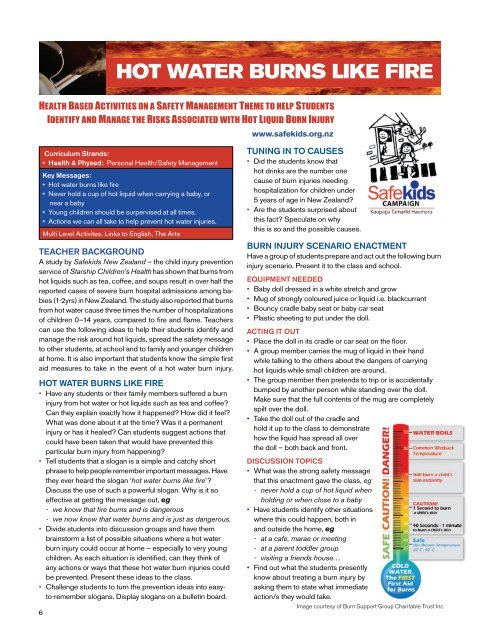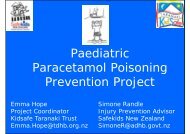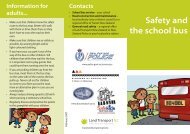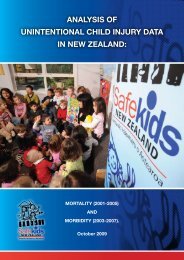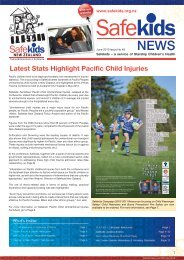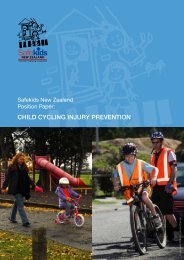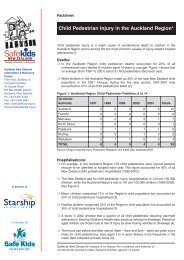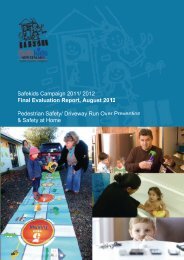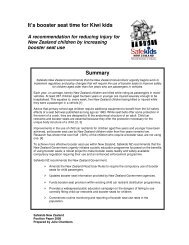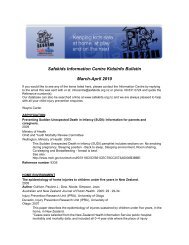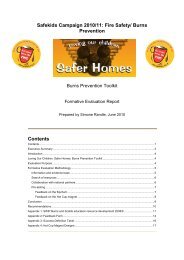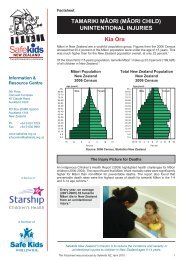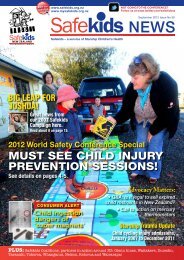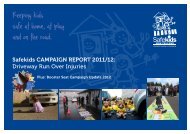"Hot Water burns Like Fire" School Project Plan - Safekids
"Hot Water burns Like Fire" School Project Plan - Safekids
"Hot Water burns Like Fire" School Project Plan - Safekids
Create successful ePaper yourself
Turn your PDF publications into a flip-book with our unique Google optimized e-Paper software.
HOT WATER BURNS LIKE FIRE<br />
HEALTH BASED ACTIVITIES ON A SAFETY MANAGEMENT THEME TO HELP STUDENTS<br />
IDENTIFY AND MANAGE THE RISKS ASSOCIATED WITH HOT LIQUID BURN INJURY<br />
www.safekids.org.nz<br />
Curriculum Strands:<br />
• Health & Physed: Personal Health/Safety Management<br />
Key Messages:<br />
• <strong>Hot</strong> water <strong>burns</strong> like fire<br />
• Never hold a cup of hot liquid when carrying a baby, or<br />
near a baby<br />
• Young children should be surpervised at all times.<br />
• Actions we can all take to help prevent hot water injuries.<br />
Multi Level Activites. Links to English, The Arts<br />
TEACHER BACKGROUND<br />
A study by <strong>Safekids</strong> New Zealand – the child injury prevention<br />
service of Starship Children’s Health has shown that <strong>burns</strong> from<br />
hot liquids such as tea, coffee, and soups result in over half the<br />
reported cases of severe burn hospital admissions among babies<br />
(1-2yrs) in New Zealand. The study also reported that <strong>burns</strong><br />
from hot water cause three times the number of hospitalizations<br />
of children 0–14 years, compared to fire and flame. Teachers<br />
can use the following ideas to help their students identify and<br />
manage the risk around hot liquids, spread the safety message<br />
to other students, at school and to family and younger children<br />
at home. It is also important that students know the simple first<br />
aid measures to take in the event of a hot water burn injury.<br />
HOT WATER BURNS LIKE FIRE<br />
• Have any students or their family members suffered a burn<br />
injury from hot water or hot liquids such as tea and coffee?<br />
Can they explain exactly how it happened? How did it feel?<br />
What was done about it at the time? Was it a permanent<br />
injury or has it healed? Can students suggest actions that<br />
could have been taken that would have prevented this<br />
particular burn injury from happening?<br />
• Tell students that a slogan is a simple and catchy short<br />
phrase to help people remember important messages. Have<br />
they ever heard the slogan ‘hot water <strong>burns</strong> like fire’?<br />
Discuss the use of such a powerful slogan. Why is it so<br />
effective at getting the message out, eg<br />
- we know that fire <strong>burns</strong> and is dangerous<br />
- we now know that water <strong>burns</strong> and is just as dangerous.<br />
• Divide students into discussion groups and have them<br />
brainstorm a list of possible situations where a hot water<br />
burn injury could occur at home – especially to very young<br />
children. As each situation is identified, can they think of<br />
any actions or ways that these hot water burn injuries could<br />
be prevented. Present these ideas to the class.<br />
• Challenge students to turn the prevention ideas into easyto-remember<br />
slogans. Display slogans on a bulletin board.<br />
6<br />
TUNING IN TO CAUSES<br />
• Did the students know that<br />
hot drinks are the number one<br />
cause of burn injuries needing<br />
hospitalization for children under<br />
5 years of age in New Zealand?<br />
• Are the students surprised about<br />
this fact? Speculate on why<br />
this is so and the possible causes.<br />
BURN INJURY SCENARIO ENACTMENT<br />
Have a group of students prepare and act out the following burn<br />
injury scenario. Present it to the class and school.<br />
EQUIPMENT NEEDED<br />
• Baby doll dressed in a white stretch and grow<br />
• Mug of strongly coloured juice or liquid i.e. blackcurrant<br />
• Bouncy cradle baby seat or baby car seat<br />
• Plastic sheeting to put under the doll.<br />
ACTING IT OUT<br />
• Place the doll in its cradle or car seat on the floor.<br />
• A group member carries the mug of liquid in their hand<br />
while talking to the others about the dangers of carrying<br />
hot liquids while small children are around.<br />
• The group member then pretends to trip or is accidentally<br />
bumped by another person while standing over the doll.<br />
Make sure that the full contents of the mug are completely<br />
spilt over the doll.<br />
• Take the doll out of the cradle and<br />
hold it up to the class to demonstrate<br />
how the liquid has spread all over<br />
the doll – both back and front.<br />
DISCUSSION TOPICS<br />
• What was the strong safety message<br />
that this enactment gave the class, eg<br />
- never hold a cup of hot liquid when<br />
holding or when close to a baby<br />
• Have students identify other situations<br />
where this could happen, both in<br />
and outside the home, eg<br />
- at a cafe, marae or meeting<br />
- at a parent toddler group<br />
- visiting a friends house…•<br />
• Find out what the students presently<br />
know about treating a burn injury by<br />
asking them to state what immediate<br />
action/s they would take.<br />
Image courtesy of Burn Support Group Charitable Trust Inc.
THIS BURN INJURY IS PREVENTABLE<br />
RESEARCHING CAUSES AND TREATMENT<br />
• Visit: www.safekids.org.nz > select Safety Topics<br />
> select Burn Injury > Download the ‘Fancy a Cuppa?<br />
Burns Prevention and First Aid Flyer’. Print out for group<br />
research or data project for a class shared reading exercise.<br />
Have students research and discuss the following:<br />
- the seriousness of spilling a hot drink over a baby<br />
- the time it takes for hot drink to cool to a safer<br />
temperature and why this is different from adults<br />
- identify and list the many situations where hot drink<br />
<strong>burns</strong> can happen<br />
- the consequences for severely burned children and the<br />
effects on their lives<br />
- identify the simple safety measures that should be taken<br />
to prevent burn injuries<br />
- the dramatic effect that giving immediate first aid can<br />
have on the burn injury<br />
- identify and understand the first aid steps that should be<br />
immediately taken.<br />
Run water from the cold<br />
tap gently over the burn for<br />
AT LEAST 20 MINUTES,<br />
or until the ambulance<br />
arrives.<br />
Image courtesy of Burn Support Group Charitable Trust Inc.<br />
• Introduce the idea that while <strong>burns</strong> from hot drinks can<br />
happen if we do not take strict safety measures, can the<br />
students think of any other situations at home where young<br />
children could suffer a burn injury from hot water? Did they<br />
think of:<br />
- pulling a boiling or hot jug off a bench<br />
- turning on the hot top at the sink or in the bath<br />
- pulling a hot drink off a bench or a table<br />
- pulling a saucepan of hot liquid off a stove<br />
- opening a microwave containing hot liquid.<br />
• Have students suggest simple measures that should be<br />
taken to prevent these situations from happening.<br />
• Do they have any rules at home that help to prevent burn<br />
injuries from hot drinks and liquids? Share these with the class.<br />
• Tell students that another important message is to supervise<br />
young children at all times.<br />
GETTING THESE MESSAGES OUT<br />
• Set the students, both as individuals and in groups, the task<br />
of getting the important burn prevention messages out to<br />
junior classes in their school and to all the members of their<br />
families. In what ways will they do this? Brainstorm ideas.<br />
Did their ideas include:<br />
- having a discussion with family members to find out<br />
what rules they have at present about being around hot<br />
water and how these rules could be improved<br />
- identifying hazards on a room-by-room basis, eg keeping<br />
jugs and cords out of reach, turning pot handles inward<br />
- designing a fridge reminder checklist for the family<br />
- preparing oral reports to give at assembly to keep the<br />
messages always fresh in other students’ minds<br />
- designing and creating posters with key messages and<br />
display in every room of the school<br />
- preparing and act out safety dramas for junior school classes<br />
- shooting scenario videos for the school website or You Tube<br />
- running a ‘safe around hot water’ slogan competition.<br />
ACTIVITIES FOR YEARS 1-3<br />
• Discuss ‘all the good things’ about warm water …<br />
baths, showers, warm drinks in winter.<br />
• Do the students know that hot water can also be<br />
dangerous? Can they think of when this could be?<br />
• Do they remember any rules that they have at home<br />
about being careful with hot water? Why do they<br />
think that they have these rules?<br />
• For homework, have students ask their parents about<br />
rules that they have at home about being safe<br />
around hot water. Share these with the class.<br />
• Why do the students think it is never safe to be<br />
close to someone carrying a hot drink? Introduce<br />
the idea that if they have a hot drink, they should<br />
always sit down to drink it.<br />
• Can they think of any dangers in their kitchen when<br />
they could be at risk of getting a painful burn from<br />
hot water? What can be done to stop this happening?<br />
• Do they have any young children at home? Explain<br />
why it is so very important to always keep the under<br />
5s away from hot water.<br />
• Have all students contribute self portraits of themselves<br />
being safe around hot water. Add stories and/or<br />
captions and display as a wall chart.<br />
• Invite a health professional to talk to the class about<br />
the dangers of <strong>burns</strong> and keeping ourselves safe.<br />
Find out what they should immediately do if they ever<br />
suffer from a burn injury.<br />
The <strong>Safekids</strong> 2011/2012 Campaign is sponsored by:<br />
Major Sponsor<br />
starters & strategies 7


